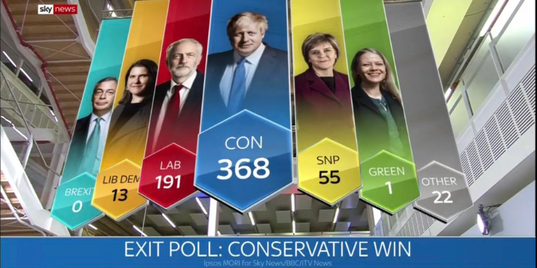The exit door. The state of Labour as Jeremy Corbyn departs

What of Labour? This is a question that almost no one is thinking about as, almost unnoticed, Jeremy Corbyn slips out of the limelight. Like the Magnificent Ambersons, Labour have got their comeuppance. They’d got it three times filled and running over. But those who had longed for it were not there to see it. And they never knew it, those who were still living had forgotten all about it, and all about them.
That irrelevance bodes ill for Labour. Just how bad is the electoral landscape and what does the new leader, expected to be Sir Keir Starmer, need to be thinking about?
The post-election analysis has concentrated on two main possible causes of Labour’s problems: Brexit and Jeremy Corbyn. One simple way of testing the importance of either of these is to look at the before and after position. What were Labour’s challenges after the 2015 election (before Brexit, before Jeremy Corbyn) and what are they now?
In 2015, Labour won 232 seats. In 2019 it won 203. So it has gone backwards by 29 seats over the course of Jeremy Corbyn’s leadership. Obviously, that is not good.
I had a look at Labour’s performance then here. I did not have a crystal ball. Brexit was just a twinkle in some evil fairy godmother’s eye. Jeremy Corbyn was still an obscure MP. What did I think had been happening then?
“Where do Labour retain strength?… London, the English Core Cities, Hull, Leicester, Coventry, Stoke, south Wales, the north east as a whole and the wider north west surrounding Liverpool, including north east Wales. Or, to put it more briefly, by and large, big cities. With worryingly few exceptions, Labour have become an almost exclusively metropolitan party. They have lost Scotland and they have lost smaller town England.”
“Labour made ten gains from the Conservatives. Only two of these seats fell clearly outside the Labour fiefdoms listed above: Hove and Lancaster & Fleetwood. Meanwhile, the Conservatives took Plymouth Moor View, Telford, Southampton Itchen, Derby North, Vale of Clwyd and Gower. Labour are getting close to maxing out in the metropolitan areas, but all the time are being edged out of smaller towns and cities – and Southampton, Derby and Plymouth are not really that small.
Many of the exceptions to the general picture – Norwich South, Cambridge, Oxford East, Exeter, Lancaster & Fleetwood – are constituencies with a large university presence. They may be smaller places, but they have much in common with the metropolitan areas. They are places where the words “urban professional” would not produce a curl of the lip.”
“If the Conservatives can broaden their appeal, they will be circling around seats like Barrow & Furness, Newcastle-under-Lyme, Derbyshire North East and Wrexham. In all of these seats the Conservatives closed the gap on Labour from 2010. There are others on the Labour defence list that are becoming increasingly marginal. However the boundaries are drawn for 2020, there will be constituencies like these that are trending away from Labour. Unless Labour changes course significantly.
More generally, if Labour does not start to broaden its appeal, it may even find that other apparent heartlands that are outside its current metropolitan focus are vulnerable to attack if other parties get their acts together. South Wales and the north east, for example, don’t fit particularly well with the rest of Labour’s current heartlands. Fortunately for Labour, its opponents in those areas are UKIP and Plaid Cymru, and neither has so far demonstrated much seat-winning prowess. But things can change. Labour needs to recognise the danger fast.”
I was not blessed with second sight but 2019 is highly consistent with all of that. I listed four seats that the Conservatives might be circling around. All four are now Conservative-held. I noted that the north east did not fit particularly well with the rest of Labour’s then heartlands. The north east swung massively to the Conservatives.
It’s always nice to be right, of course, but that’s not my main point (it is a subsidiary point, I admit). My main point is that neither Jeremy Corbyn nor Brexit seem particularly to have altered the axis between Labour and the Conservatives. If anything, it is striking how little that has happened. The pendulum seems simply to have swung more in the Conservatives’ favour.
So the first thing that the new Labour leader needs to realise is that Labour’s problems are very deep-rooted indeed. Jeremy Corbyn and Brexit may well not have helped. A successful Labour leader, however, is not just going to remedy the damage they might have caused but also tackle the pre-existing difficulty that Labour had in talking to those who live outside Britain’s biggest cities.
Having looked back to how things have changed (or not changed) since 2015, what new electoral trends should the next Labour leader be thinking about? That will be for my next post.